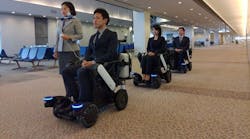Self-Driving Electric Wheelchairs to be Tested at Narita Airport
Generally speaking, airlines are required to provide assistance to passengers with a disability as they navigate through the key function areas of an airport. It includes getting them to the gate location of their flight and to ticket counters, baggage claim, and vehicle pickup locations.
Addressing that issue, Japan’s All Nippon Airways (ANA) and Panasonic announced they will work together to test a new generation of self-driving electric wheelchairs, as part of a plan to increase mobility and accessibility options at Tokyo Narita International Airport.
Since Narita Airport is an international hub, many travelers must walk a long distance to reach their connecting flights on time. The airport's size and high volume of activity can make this inconvenient, and this difficulty is only compounded for elderly travelers with mobility issues. To meet these demands and keep Narita Airport operating at a high level, especially in light of the upcoming 2020 Summer Olympics in Tokyo, ANA and Panasonic are teaming to run trials on new electric wheelchairs with tracking capabilities that allow them to navigate the bustling airport.
"Narita Airport is a gateway to Japan for millions of travelers every year and we seek to partner with other leading Japanese innovators to make sure that arrival, departure and making connections are all as convenient as possible," says Juichi Hirasawa, Senior Vice President of ANA. "ANA's partnership with Panasonic will make Narita Airport more welcoming and accessible, both of which are crucial to maintaining the airport's status as a hub for international travel in the years to come.”
These wheelchairs will be capable of safely navigating through the airport independently. Jointly developed by Panasonic and WHILL Co. Ltd., the wheelchairs are able to detect and avoid and obstacles on the way to their destinations. Front- and rear-mounted cameras and sensors provide wide angle visibility and obstacle detection.
ANA is taking a “wagon train” approach to transporting passengers around Narita Airport via self-driving wheelchairs.
Pre-collected map data is compared against current driving situations to create the safest and optimal route for the rider. In the event an object unsafely enters its pathway, an auto-stop function will prevent a collision. For further assurance of safety at Narita, the self-driving electric wheelchairs will operate by following a predetermined leader to a common destination (see figure), and ANA staff will be on hand to serve as guides.
Wheels Go Multiple Ways
The omnidirectional wheel is one of the more interesting technological features of WHILL’s Personal EVs, which can travel up to 12 miles indoors or outdoors between charges, run at up to 5 mph, and climb obstacles up to two inches in height. Omnidirectional wheels roll forward like normal wheels, but also can slide sideways without skidding during turns. Conventional omnidirectional wheel technology was invented for vehicles such as forklifts. However, according to WHILL, it hasn’t been applied effectively for wheelchairs and mobility devices due to several design flaws in previous implementations.
The omnidirectional front wheels engineered by WHILL use 24 small rollers that collectively create one large wheel. The rollers all move individually, allowing the EV wheelchair to glide sideways and achieve a tighter turning radius, while simultaneously providing greater terrain coverage.
The fact that omni-wheels don’t need to swivel eliminates the dangers and difficulty often found using swiveling casters. Casters need additional room to rotate before changing direction; as they rotate, they can get stuck against walls and obstacles. They can also get tangled up in a user’s feet as they rotate, causing injury.
Wheelchairs assist people with disabilities to become productive members of their communities. Over 3 million Americans rely on wheelchairs to get around, and globally, some 65 million people have disabilities that require a wheelchair, according to World Heath Organization statistics.
Initially, WHILL is aiming for commercialization at airports and commercial facilities. Then the hope is to integrate the technology and devicees at major tourist attractions and pedestrian thoroughfares.
The long-term vision of WHILL is to allow people to summon its wheelchairs via a smartphone app in locations such as theme parks, museums, hospitals, shopping malls, airports, and city centers. Once summoned and when the rider is properly seated, the person could then tell the wheelchair where to go, and be driven there autonomously. An iPhone or Android app would also be used to lock/unlock the vehicle to keep it secure, and to select a drive mode that’s right for the rider. Afterwards, the wheelchair would return to its docking station to recharge.



